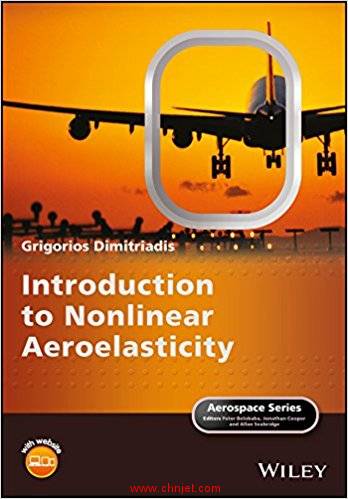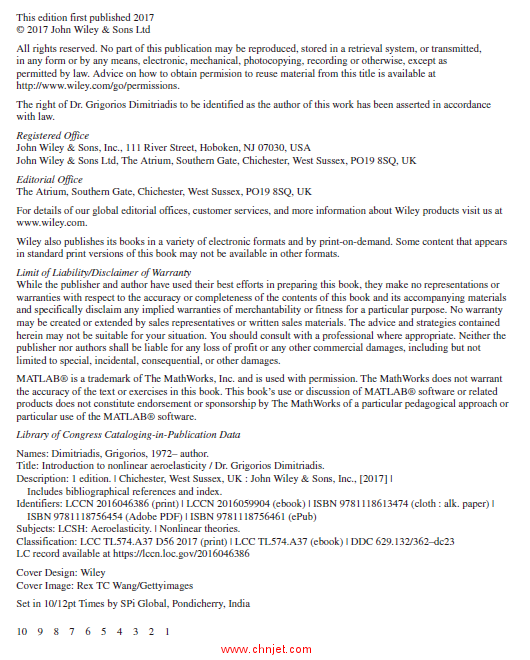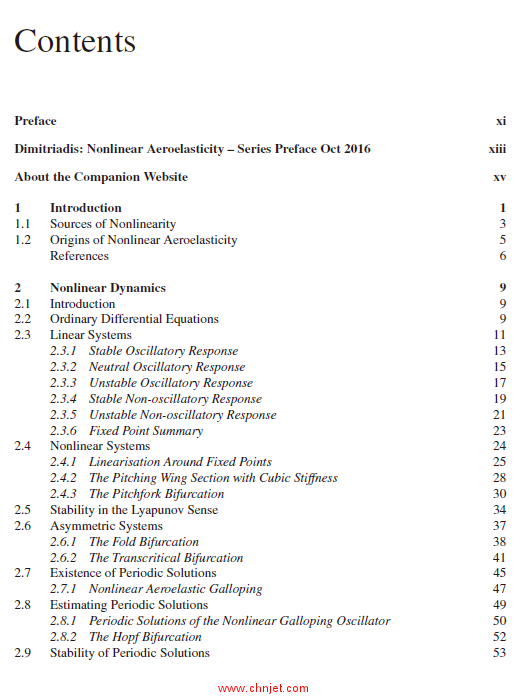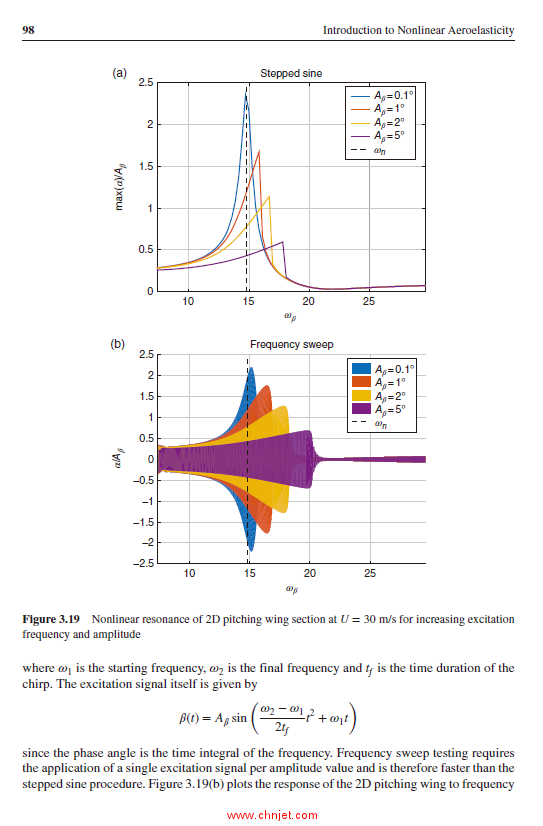马上注册,结交更多好友,享用更多功能,让你轻松玩转社区。
您需要 登录 才可以下载或查看,没有账号?立即注册

×
《Introduction to Nonlinear Aeroelasticity》
非线性气动弹性的介绍
作者:Grigorios Dimitriadis
University of Liège
Belgium
出版社:Wiley
出版时间:2017年
《Introduction to Nonlinear Aeroelasticity》

《Introduction to Nonlinear Aeroelasticity》

《Introduction to Nonlinear Aeroelasticity》

《Introduction to Nonlinear Aeroelasticity》

目录
Preface xi
Dimitriadis: Nonlinear Aeroelasticity – Series Preface Oct 2016 xiii
About the CompanionWebsite xv
1 Introduction 1
1.1 Sources of Nonlinearity 3
1.2 Origins of Nonlinear Aeroelasticity 5
References 6
2 Nonlinear Dynamics 9
2.1 Introduction 9
2.2 Ordinary Differential Equations 9
2.3 Linear Systems 11
2.3.1 Stable Oscillatory Response 13
2.3.2 Neutral Oscillatory Response 15
2.3.3 Unstable Oscillatory Response 17
2.3.4 Stable Non-oscillatory Response 19
2.3.5 Unstable Non-oscillatory Response 21
2.3.6 Fixed Point Summary 23
2.4 Nonlinear Systems 24
2.4.1 Linearisation Around Fixed Points 25
2.4.2 The Pitching Wing Section with Cubic Stiffness 28
2.4.3 The Pitchfork Bifurcation 30
2.5 Stability in the Lyapunov Sense 34
2.6 Asymmetric Systems 37
2.6.1 The Fold Bifurcation 38
2.6.2 The Transcritical Bifurcation 41
2.7 Existence of Periodic Solutions 45
2.7.1 Nonlinear Aeroelastic Galloping 47
2.8 Estimating Periodic Solutions 49
2.8.1 Periodic Solutions of the Nonlinear Galloping Oscillator 50
2.8.2 The Hopf Bifurcation 52
2.9 Stability of Periodic Solutions 53
vi Contents
2.9.1 Stability of Galloping Oscillations 55
2.9.2 Supercritical and Subcritical Hopf Bifurcations 56
2.9.3 The Fold Bifurcation of Cycles 56
2.10 Concluding Remarks 61
References 61
3 Time Integration 63
3.1 Introduction 63
3.2 Euler Method 64
3.2.1 Linear Systems 65
3.2.2 Nonlinear Systems 66
3.3 Central Difference Method 68
3.3.1 Explicit Solution of Nonlinear Systems 69
3.3.2 Implicit Solution of Nonlinear Systems 72
3.4 Runge–Kutta Method 74
3.5 Time-Varying Linear Approximation 80
3.6 Integrating Backwards in Time 86
3.7 Time Integration of Systems with Multiple Degrees of Freedom 88
3.8 Forced Response 92
3.9 Harmonic Balance 99
3.9.1 Newton–Raphson 103
3.9.2 Discrete Fourier Transform Techniques 106
3.10 Concluding Remarks 110
References 111
4 Determining the Vibration Parameters 113
4.1 Introduction 113
4.2 Amplitude and Frequency Determination 113
4.2.1 Event Detection 117
4.3 Equivalent Linearisation 120
4.4 Hilbert Transform 125
4.5 Time-Varying Linear Approximation 129
4.6 Short Time Fourier Transform 131
4.7 Pinpointing Bifurcations 137
4.7.1 Newton–Raphson 141
4.7.2 Successive Bisection 142
4.8 Limit Cycle Study 143
4.9 Poincaré Sections 146
4.10 Stability of Periodic Solutions 149
4.10.1 Floquet Analysis 152
4.11 Concluding Remarks 156
References 156
5 Bifurcations of Fundamental Aeroelastic Systems 159
5.1 Introduction 159
Contents vii
5.2 Two-Dimensional Unsteady Pitch-Plunge-Control Wing 160
5.3 Linear Aeroelastic Analysis 161
5.4 Hardening Stiffness 170
5.4.1 Supercritical Hopf Bifurcation 170
5.4.2 Subcritical Hopf Bifurcation 180
5.4.3 Fold Bifurcation of Cycles 183
5.4.4 Flutter of Nonlinear Systems 189
5.4.5 Period-Doubling Bifurcation 193
5.4.6 Torus Bifurcation 201
5.5 Softening Stiffness 209
5.6 Damping Nonlinearity 214
5.6.1 Subcritical Hopf Bifurcation 216
5.6.2 Static Divergence of Cycles 220
5.6.3 Pitchfork Bifurcation of Cycles 224
5.7 Two-Parameter Bifurcations 233
5.7.1 Generalised Hopf Bifurcation 233
5.7.2 Pitchfork–Hopf Bifurcation 237
5.7.3 Hopf-Hopf Bifurcation 240
5.8 Asymmetric Nonlinear Aeroelastic Systems 242
5.8.1 Fold Bifurcation of Fixed Points and Cycles 243
5.8.2 Transcritical Bifurcation of Fixed Points and Cycles 251
5.8.3 Fold-Hopf Bifurcation 256
5.9 Concluding Remarks 257
References 259
6 Discontinuous Nonlinearities 261
6.1 Introduction 261
6.2 Piecewise Linear Stiffness 262
6.2.1 Underlying and Overlying Linear Systems 264
6.2.2 Fixed Points and Boundary Equilibrium Bifurcations 269
6.2.3 Equivalent Linearisation of Piecewise Linear Stiffness 272
6.2.4 Three-Domain Limit Cycles 278
6.2.5 Two-Domain Limit Cycles 285
6.2.6 Time Domain Solutions 289
6.3 Discontinuity-Induced Bifurcations 297
6.3.1 The Boundary Equilibrium Bifurcation 297
6.3.2 The Grazing Bifurcation 302
6.4 Freeplay and Friction 309
6.5 Concluding Remarks 310
References 310
7 Numerical Continuation 313
7.1 Introduction 313
7.2 Algebraic Problems 314
7.2.1 Prediction Correction 316
viii Contents
7.2.2 Arclength Continuation 321
7.2.3 Pseudo-Arclength Continuation 327
7.3 Direct Location of Folds 328
7.4 Fixed Point Solutions of Dynamic Systems 332
7.4.1 Branch Points 332
7.4.2 Arclength Step Control 337
7.5 Periodic Solutions of Dynamic Systems 342
7.5.1 Starting the Continuation Scheme 348
7.5.2 Folds and Branch Points 351
7.5.3 Branch Switching 355
7.6 Stability of Periodic Solutions Calculated from Numerical Continuation 358
7.7 Shooting 364
7.7.1 Starting the Continuation Scheme 367
7.7.2 Arclength Continuation 368
7.7.3 Stability Analysis 370
7.7.4 Branch Point Location and Branch Switching 372
7.7.5 Grazing 375
7.8 Harmonic Balance 379
7.9 Concluding Remarks 387
References 387
8 Low-Speed Aerodynamic Nonlinearities 389
8.1 Introduction 389
8.2 Vortex-Induced Vibrations 393
8.3 Galloping 402
8.4 Stall Flutter 411
8.4.1 Dynamic Stall 413
8.4.2 Leishman–Beddoes Model 417
8.4.3 ONERA Model 434
8.4.4 Aeroelastic Simulations using Dynamic Stall Models 442
8.5 Concluding Remarks 449
References 449
9 High-Speed Aeroelastic Nonlinearities 453
9.1 Introduction 453
9.2 Piston Theory 453
9.3 Panel Flutter 468
9.3.1 Buckling 470
9.3.2 Limit Cycle Oscillations 484
9.4 Concluding Remarks 501
References 501
10 Finite Wings 503
10.1 Introduction 503
10.2 Cantilever Plate in Supersonic Flow 504
Contents ix
10.3 Three-Dimensional Aerodynamic Modelling by the Vortex Lattice Method 519
10.3.1 Aeroelastic Coupling 528
10.3.2 Transforming to the Time Domain 536
10.3.3 Nonlinear Response 542
10.4 Concluding Remarks 552
References 552
Appendix A: Aeroelastic Models 555
Index 571
专业书籍
下载地址:(回复后可见)
| ![]()